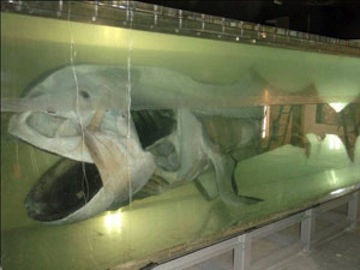340514-megamouth.jpg

Preserved megamouth shark, showing cartilaginous skeleton and large mouth. Credit: Okinawa Charaumi Aquarium/NOAA
For a big creature with big jaws, the megamouth shark keeps an unusually quiet profile. In fact, it wasn’t discovered until 1976, and only about 60 have ever been recorded.
The megamouths that have been seen are about 12 to 17 feet long, with loose, flabby bodies. Their mouths are several feet wide. The combination makes them look more like a cartoonist’s idea of a friendly shark than a terror from the deep.
And in fact, the megamouth is a terror only to the tiny shrimp-like creatures known as krill and other small organisms. That’s because it’s a filter feeder. It probably swims through the ocean with its mouth wide open, filtering the tiny edible creatures from the water. It does have teeth — about 50 rows of them, in fact — but they’re small, and most of them are never used.
Of all the megamouth sharks ever recorded, all but a few were seen in the Pacific Ocean, including a few off the coast of California, with only a smattering of others in the Atlantic and Indian oceans.
And only one megamouth has been studied in any kind of detail in the wild. Marine biologists managed to tag it with a tracking device that worked for a couple of days. It revealed that the shark stayed fairly close to the surface during the day, then dropped several hundred feet down at night. That suggests it was following the supply of krill and other small organisms, which move up and down at different times of day.
For the most part, though, the life of a megamouth shark remains a quiet mystery.

